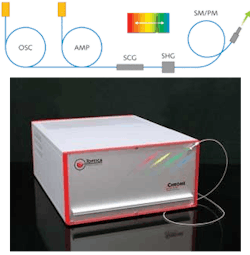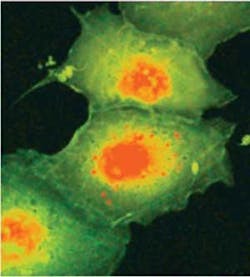TUNABLE LASER SOURCES: Fully tunable visible laser source is valuable for biophotonics
FRANK LISON and THOMAS HELLERER
Many biophotonic applications such as fluorescence and confocal microscopy, flow cytometry, and screening techniques in drug discovery require multiple wavelengths for excitation or activation of fluorophores. Conventional light sources such as xenon arc lamps, mercury lamps, and halogen lamps are typically used because they emit over the entire visible region. However, for excitation of a specific fluorophore (which requires only a narrow wavelength band), all but a small portion of the lamp’s spectrum is filtered out, which vastly reduces the brightness of the light source. A fully tunable laser is a more efficient source for these applications and now wavelength adjustments are even easier with a new tunable fiber-laser module that can be automatically set to provide output at any wavelength in the visible from 488 to 640 nm (see Fig. 1).
Laser sources
Many applications require a relatively small spectral width, a diffraction-limited output beam, and/or the highest possible spectral brightness with no spectral side lobes or other spectral effects close to the excitation line. These requirements can only be fulfilled by a laser source. If fluorescence-lifetime imaging data are also of interest, several more (pulsed) lasers must be added. Each of these individual lasers has one or more spectral lines.
Over the past few years in particular, the noise performance and beam quality of these lasers have been optimized for biophotonics; however, the integration of the different sources and the spatial superposition of their beams remain a challenge for the manufacturer. For aftermarket integrators or end users, this integration is nearly impossible. Moreover, none of these existing sources is tunable over a significant wavelength region.
A straightforward approach is to put as many lasers as possible together in one housing, using optics for combining the different output beams and adding an acousto-optic tunable filter (AOTF) for intensity modulation and control. The single output beam of this multilaser box is then coupled to the experimental apparatus—such as a microscope—via some sort of fiber-optic connection. Most microscope manufacturers have such a device in their portfolio.
Today’s compact solid-state and/or diode lasers make the integration more straightforward, and output power is no longer a limiting factor. However, misalignment is still an issue. In addition, if fast modulation is needed, external means are sometimes necessary because not all these lasers can be directly modulated. In the end, these integration boxes are large and need installation, and, in the worst case, even realignment. Clearly, the lifetime of such a system is limited by the weakest component.
Ultrachrome lasers
New laser sources recently introduced into the market overcome many of these limitations. These laser sources directly cover most of the visible range and can therefore be described best by the term “ultrachrome” laser sources. Such sources can be grouped into four types (see table for typical parameters), the dye laser (widely tunable, pulsed), the optical parametric oscillator (OPO), the supercontinuum light source—also known as a white-light source (WLS), and the fully tunable visible laser source (for example, the Toptica iChrome).Back in the 1980s, tunable pulsed dye lasers were the prevalent tunable laser source, but they were only considered because there was no alternative at the time. In addition to the required tweaking and alignment, the dye and sometimes even the pump laser had to be changed to cover a large spectral range.
The next option that became available in the visible range was the OPO. The advantages of OPOs are their broad wavelength coverage and the high maximum output power. Though this kind of system has been improved over the past years, nonstop operation is still not typical; most of these systems need supervision by an experienced laser technician every now and then.
Even more recently, direct white-light laser sources (also known as supercontinuum light sources) became available. These sources can indeed decrease the gap between real-world laser-source properties and the needs of the user. But though supercontinuum light sources are widely tunable, they still face severe problems. Electrical-to-optical-efficiency-related heat load, limited lifetime, polarization-rotation issues, and noise figures are far beyond the current agreed acceptance range.
The biggest issue for biophotonics, however, is the fact that all colors are present simultaneously in a supercontinuum light source. This might seem at first to be a big advantage, especially because with clever filtering techniques, multiple separate wavelengths can be obtained from the continuum and used at the same time. However, this is actually a major drawback. Because all colors are present at once, unwanted photons must be filtered out so that, out of several watts of total optical power, only a few milliwatts remain in the spectral region of interest—less than one-tenth of a percent of the total power is available for excitation of a fluorophore.
The suppression of neighboring unwanted colors is currently only possible to the order of 10-4, a number comparable to the typical ratio of excitation to fluorescence and backreflected photons detected in the optical instrument. The signal-to-noise ratio is thereby drastically degraded. All unused photons are converted into a thermal load inside the instrument—or even worse, within the sample under study.
Fully tunable laser sources
An alternative to the supercontinuum light source is a fully tunable laser source. This type of laser can immediately replace most of the others for biophotonic applications in the visible. Applications include fluorescence spectroscopy and microscopy, time-resolved spectroscopy and microscopy, and characterization of sharp-edge-filter characteristics.
A new tunable laser module is based completely on fiber-laser technology and has the flexibility to automatically set the laser output to any wavelength in the visible from 488 to 640 nm. In contrast to conventional white-light sources, the narrow-bandwidth pulses of the fully tunable laser are not filtered out from an intrinsically noisy supercontinuum; even the coherence is preserved during the frequency-generation processes. This process ensures through its very nature that the visible light exhibits the best possible intensity-noise performance.
The frequency-conversion process consists of two steps. First, ultrashort laser pulses delivered by the fiber laser are fed into a nonlinear fiber, where they undergo a four-wave-mixing process: two new colors emerge that are blue- and red-shifted with respect to the input wavelength. Because of the coherence of this process, efficient generation of the new colors requires a so-called phase-matching condition to be fulfilled. Varying the peak power of the laser pulses through pulse-shaping optics results in phase-matching of different colors. In this controlled way, the blue-shifted portion alone can be tuned over more than 400 nm in the IR.
The second step involves a straightforward frequency-conversion scheme: the second-harmonic generation of the blue-shifted light into the visible, which results in spectrally clean laser pulses tunable from 488 to 640 nm. Because both processes are of a coherent nature, the coherence of the laser pulses is preserved throughout the entire conversion process. The polarization-maintaining nonlinear fiber results in a high polarization-extinction ratio, which is essential for the efficiency of the subsequent second-harmonic generation and also useful for many applications.
Ultrachrome laser sources based on this last approach have intrinsically low noise, the most-accurate timing precision, and optimum suppression of nearby colors. They are well-suited for spectroscopy and metrology in general, but in particular for biophotonic applications. Advantages of these novel systems as compared to standard lasers have been shown on applications such as fluorescence-lifetime measurements (see Fig. 2); excitation spectra measurements of, for example, new fluorophores; confocal microscopy; characterization of optical properties over a wide wavelength range; and, with a combination of two such laser systems, two-color pump-probe measurements.From a different perspective, ultrachrome lasers represent a significant step toward an optical-frequency generator analogous to radio-frequency generators for electronics. Regarded as a single-box rack-mount frequency generator, the iChrome covers the frequency range from 465 to 625 THz with a narrow 2 THz output that can be scanned at 50 THz/s and set with an accuracy of better than 1 THz to any frequency in that range. Noise figures are well within the level that standard single-line state-of-the-art laser sources are expected to have.
Integration
For an ultrachrome laser source to offer the same convenience of use that, for example, an arbitrary waveform generator in the electronics world has today, much work must be done on the interface and on the standardization of laser interfaces in general. For the iChrome system development we took a new approach by integrating a Linux-based operating system that includes a Web server. The laser system can be accessed via all standard computer interfaces as well as a standard Web browser via an Ethernet connection. This interface gives access to all laser parameters, the laser history, and (via a dedicated service menu) status flags and error logging. In this way, multiple lasers can be integrated into a homogenous system.
Frank Lison is vice president of research and development and Thomas Hellerer is sales manager of ultrafast fiber lasers at TOPTICA Photonics, Lochhamer Schlag 19, D-82166 Graefelfing/Munich; www.toptica.com; e-mail: [email protected].


